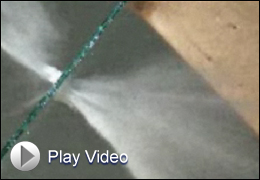Headline Archives |
||||||
| COVERING ALL THE ANGLES Our Experts Reconstruct Shooting Incidents |
||||||
| 12/12/08 | ||||||
|
When police officers raided a suspected drug dealer’s house, the suspect emerged into a hallway brandishing a pistol. He fired and hit the wall next to one officer, spraying drywall everywhere. The officer and his two partners returned fire as the suspect dove into a bathroom. In a matter of seconds, bullets were flying from four different guns.
After the shooting, local authorities called in experts from the FBI Laboratory to reconstruct the incident. By the time our firearms examiners completed their meticulous work, not only had they documented 198 bullet holes at the crime scene, they could tell with a high degree of certainty who had fired the bullets, where the shooters were positioned when they fired, and which gun fired the shot that wounded the sleeping man in the bedroom. Using everything from old-fashioned tape measures, protractors, and basic trigonometry to the newest surveying equipment and laser scanners, firearms examiners and graphics specialists work together to provide critical information to investigators—and later to prosecutors and juries at trial—regarding bullet trajectories and the weapons used in the commission of crimes.
“Our scientific process allows us to look in very specific places for evidence,” says one veteran examiner. This often leads to the discovery of new evidence, like a bullet lodged in an out-of-the-way place. “There’s a chance that the bullet we find could help solve the case,” he explains. At the crime scene, examiners strive to understand how the shooting unfolded. Where was the shooter standing? How far away from the victim and at what angle? Were all the bullets fired from the same gun? A reconstructed shooting scene can look a lot like a science project. First, a grid is established so that everything can be logged and precisely measured against it. Next, bullet holes are located, and long, thin metal dowels called “trajectory rods” are placed in the holes to help determine exact angles. In complicated cases, computer graphics are generated to help better understand the scene. If a shooting occurs inside a house, where there are plenty of right angles, aligning measurements to a grid can be easier than if the shooting occurs in a car, where there are mostly rounded surfaces. In that case, a grid is established around the vehicle. Back at the FBI Laboratory in Quantico, Virginia, bullet fragments and shell casings can be microscopically compared, and weapons can be test-fired into a specially designed water tank that allows a fired bullet to remain intact. It’s all part of the analysis that ultimately leads to a report containing the examiners’ findings. At the Lab, we maintain an inventory of 16,000 different types of ammunition, along with nearly 6,000 firearms. In fact, FBI examiners are so knowledgeable that they regularly provide instruction to our law enforcement partners around the world. “When it comes to bullet trajectories, you really have to take time to cover all the angles—quite literally,” says our examiner. “It’s challenging and painstaking work, but it’s very rewarding when we help solve a case.” Resources: |
 |
 |
 |
|
|
|
|
||
|
